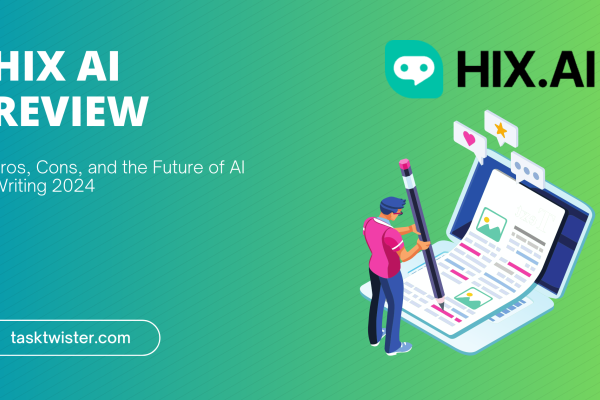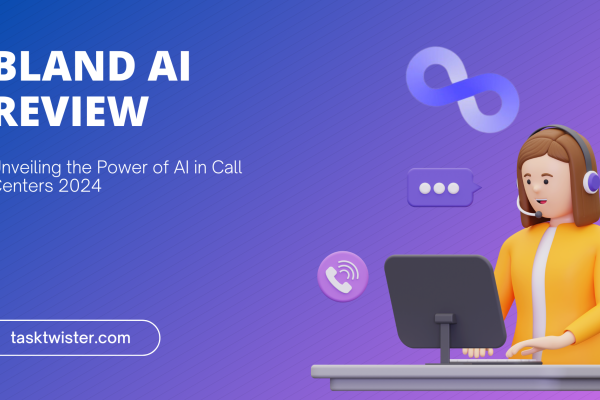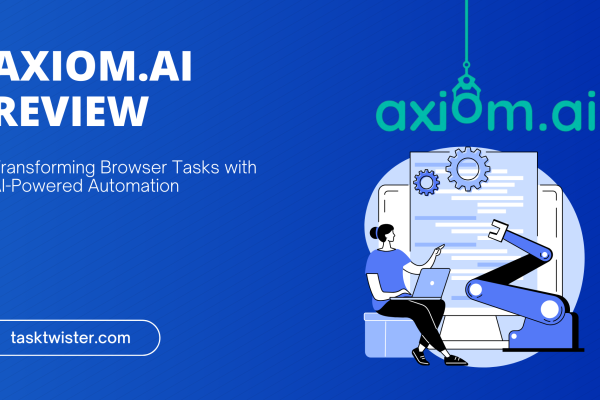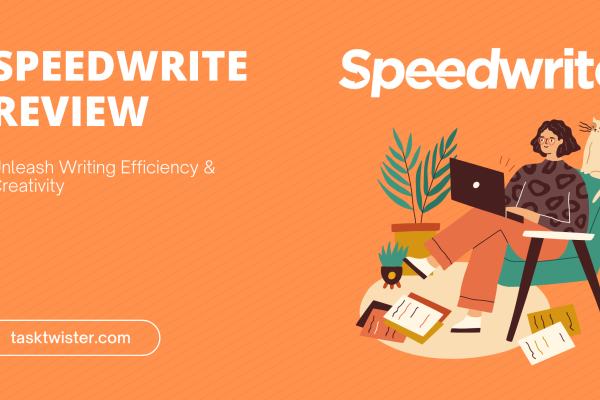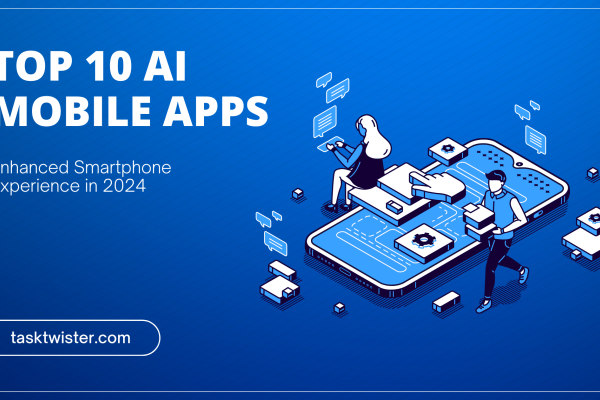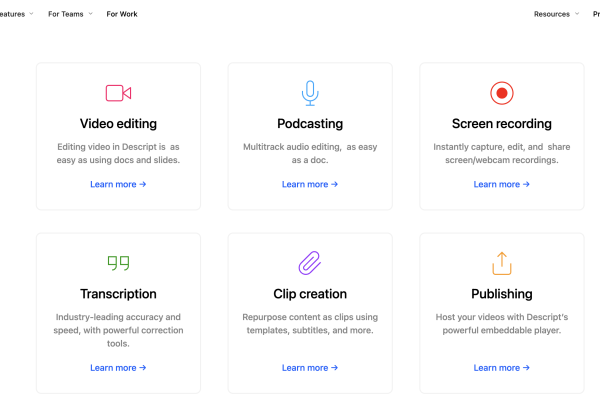Top 10 AI Writing Tools 2023: Revolutionizing Content Creation
Noah
Table of Contents
Chapter 1: Introduction to AI Writing Tools
1.1 The Evolution of AI Writing Software
The realm of digital content creation has been revolutionized with the advent of AI writing tools. From their nascent stages as basic grammar checkers to sophisticated AI-driven content generators, these tools have transformed how we approach writing and editing. Initially designed to correct simple punctuation and grammatical errors, AI writing software has evolved into a dynamic ally for writers, encompassing a broad spectrum of functionalities including content optimization and style editing.
- Relume AI Review: Revolutionizing Web Design with an AI-Powered Website Builder
- Vidyo AI Review 2024: Revolutionizing Video Editing for Content Creators
- Unbounce Review 2023: Unveiling the True Potential of This Landing Page Builder
- FlexClip Review 2023: Transform Your Video Editing Experience
- How BeFunky AI is Redefining Photo Editing
1.2 Benefits of Using AI Writing Tools
AI writing tools have become indispensable for a diverse range of users, from blog writers to social media marketers. They offer numerous benefits that enhance the quality and efficiency of content creation:
You are viewing: Top 10 AI Writing Tools 2023: Revolutionizing Content Creation
- Enhanced Efficiency: Automated writing solutions significantly reduce the time and effort involved in content creation. AI tools can generate drafts, suggest improvements, and even write entire pieces of content, enabling faster turnaround times.
- Improved Accuracy: With advanced grammar and punctuation error detection capabilities, these tools ensure a high level of linguistic precision. This accuracy is crucial in maintaining the credibility and professionalism of the content.
- Content Optimization: SEO content writing is a vital aspect of digital marketing, and AI tools excel in this domain. They analyze keyword trends and optimize content for better search engine rankings, ensuring greater online visibility.
- Versatility in Content Creation: Whether it’s crafting engaging blog posts or compelling social media updates, AI writing software offers a range of templates and styles to suit various content needs.
- Content Readability and Engagement: Tools like the Hemingway Editor focus on content readability, making complex information accessible and engaging to a broader audience.
1.3 Overview of the Market Trends in 2023
In 2023, the market for AI writing tools shows a trend towards more sophisticated AI content analysis and generation capabilities. AI writing innovation is at its peak, with tools becoming more intuitive and capable of producing content that closely mimics human writing. The integration of AI in content creation has led to a surge in demand for these tools, making them a staple in the arsenal of digital content creators.
- Rise of AI Content Generators: The popularity of AI content generators has soared, with tools like Writesonic and Copy.ai leading the pack. They offer an array of features that cater to different content creation needs, from short social media posts to long-form content.
- Focus on AI Editing Assistance: More emphasis is being placed on the editing capabilities of AI tools. Beyond basic grammar checks, these tools now offer suggestions on style, tone, and overall content structure.
- Customization and AI Tool Features: Customization is key in 2023, with AI writing tools offering more personalized experiences. Users can tailor the tool’s output to match their unique writing style and content objectives.
- Integration and Collaboration: AI writing tools are increasingly being integrated with other software platforms, enhancing their utility and ease of use in a collaborative work environment.
Chapter 2: Criteria for Selecting AI Writing Tools
2.1 Key Features to Look For
In the dynamic landscape of AI writing tools, identifying the pivotal features that elevate a tool from good to exceptional is crucial. When delving into the realm of AI-driven content creation, certain attributes stand out:
- Advanced Grammar and Punctuation Checks: The foundation of any AI writing software is its ability to rectify grammatical errors and ensure punctuation precision. This feature is vital for maintaining the professional integrity of the content.
- Content Readability Enhancements: Tools that offer readability assessments, like the Hemingway Editor, aid in crafting content that resonates with the target audience. It’s not just about error-free writing but also about delivering a clear, concise message.
- SEO Optimization Capabilities: For content creators and marketers, the tool’s ability to optimize content for search engines is a game-changer. This includes keyword integration, SEO content writing suggestions, and analytics to track content performance.
- Diverse Content Templates: A tool with a range of templates for blog writing, social media posts, and other formats adds versatility, catering to various content needs.
- AI Editing Assistance and Suggestions: Beyond basic corrections, AI tools that offer stylistic and structural suggestions can significantly enhance the quality of the written piece.
2.2 Understanding Different Pricing Models
AI writing tools come with various pricing structures, and understanding these is essential for selecting a tool that aligns with your budget and usage needs:
- Subscription-Based Models: Many AI tools, like Grammarly and Writesonic, offer monthly or annual subscriptions. These plans often come with tiered features, allowing users to choose based on their requirement intensity.
- Pay-As-You-Go Options: Some tools provide a usage-based pricing model, ideal for users with fluctuating content creation needs. This flexibility ensures you pay only for what you use.
- Free Versions with Limited Features: Several AI writing tools offer free versions with basic functionalities. These are perfect for individuals or small businesses starting with AI-driven content creation.
2.3 Identifying the Ideal User Base for Each Tool
Each AI writing tool has its unique strengths, making it more suitable for certain user groups:
- For Bloggers and Content Creators: Tools like Anyword and ContentatScale.ai, with their long-form content generation capabilities, are ideal for bloggers and content creators focusing on in-depth articles.
- Social Media Marketers: AI tools that provide quick, catchy content generation, like Writesonic, are a boon for social media marketers who need to churn out engaging posts regularly.
- Academic and Technical Writers: Tools with robust grammar checker and content analysis features are more suited for academic or technical writers who require precision and detail in their writing.
- Businesses Focused on SEO: AI tools that integrate SEO content writing features and content optimization are crucial for businesses looking to enhance their online presence.
Chapter 3: In-Depth Analysis of Top 10 AI Writing Tools of 2023
3.1 Copy.ai – Best for Overcoming Writer’s Block

Copy.ai stands out as a premier solution for individuals grappling with writer’s block. Utilizing advanced AI-driven content generation, this tool sparks creativity and assists in producing diverse forms of content ranging from blog posts to compelling social media updates.
Features:
- Intuitive content generation: Offers an array of creative prompts.
- Diverse content templates: Caters to various writing needs.
- AI-driven brainstorming: Facilitates idea generation.
Pricing:
- Free version with basic features.
- Pro version starting at $49/month.
Pros & Cons:
- Pros: User-friendly interface, excellent for generating creative content.
- Cons: May lack depth in technical or niche topics.
3.2 Rytr – Ideal for Copywriters

Rytr serves as a reliable ally for copywriters, providing efficient tools for crafting persuasive and engaging copy. Its capabilities extend to generating high-quality, conversion-oriented content with ease.
Features:
- Versatile copywriting templates.
- Built-in tone and style customization.
- SEO optimization for content.
Pricing:
- Starter plan: Free with limitations.
- Premium plan: $29/month.
Pros & Cons:
- Pros: Wide range of use-cases, easy to use.
- Cons: Limited creative freedom compared to human writing.
3.3 QuillBot – Top Choice for Students and Academics

QuillBot specializes in paraphrasing and summarizing, making it a favorite among students and academics. Its ability to refine and transform existing content while maintaining original meaning stands unparalleled.
Features:
- Advanced paraphrasing tool.
- Summarization capabilities.
- Grammar and punctuation checker.
Pricing:
- Free version available.
- Premium plans start at $9.95/month.
Pros & Cons:
- Pros: Excellent for academic writing, integrates well with research workflows.
- Cons: Sometimes requires manual tweaking for optimal results.
3.4 Frase.io – Preferred by SEO Teams and Content Managers
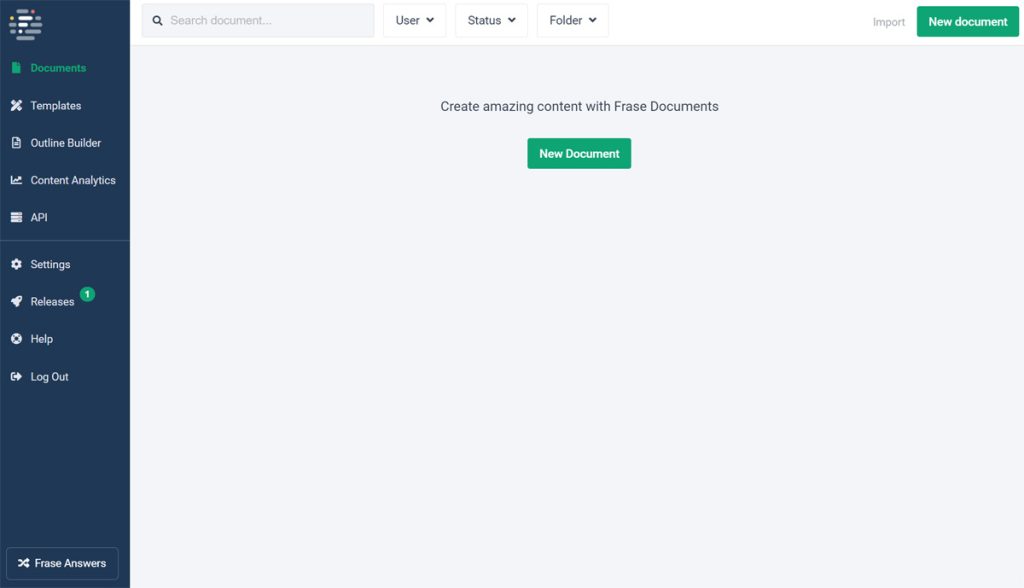
Frase.io is a robust AI writing assistant focused on SEO and content management. It excels in creating and optimizing content for search engines, making it an indispensable tool for digital marketing professionals.
Features:
- SEO content optimization.
- Automated content briefs.
- User intent analysis.
Pricing:
- Starts at $14.99/user/month.
Pros & Cons:
- Pros: Comprehensive SEO tools, intuitive interface.
- Cons: Higher learning curve for beginners.
3.5 Anyword – Excellent for Blog Writing

See more : Neuroflash Review: A New Era in AI-Driven Content Creation
Anyword is tailored for bloggers and content creators, offering AI editing assistance and content optimization to elevate blog writing. Its predictive analytics suggest improvements to increase reader engagement.
Features:
- Predictive performance scoring.
- Diverse language support.
- Integration with various blogging platforms.
Pricing:
- Basic plan starts at $49/month.
Pros & Cons:
- Pros: Increases content engagement, user-friendly.
- Cons: Limited functionality in the basic plan.
3.6 Grammarly – Leader in Grammatical and Punctuation Error Detection

Grammarly is renowned for its unparalleled grammar checking and editorial suggestions. It is an essential tool for anyone seeking to polish their writing to a professional standard.
Features:
- Advanced grammar and punctuation checker.
- Tone detection and stylistic suggestions.
- Plagiarism detector.
Pricing:
- Free basic version.
- Premium plans start at $12/month.
Pros & Cons:
- Pros: Highly accurate, versatile in application.
- Cons: Premium version required for full feature access.
3.7 Hemingway Editor – Best for Content Readability Measurement
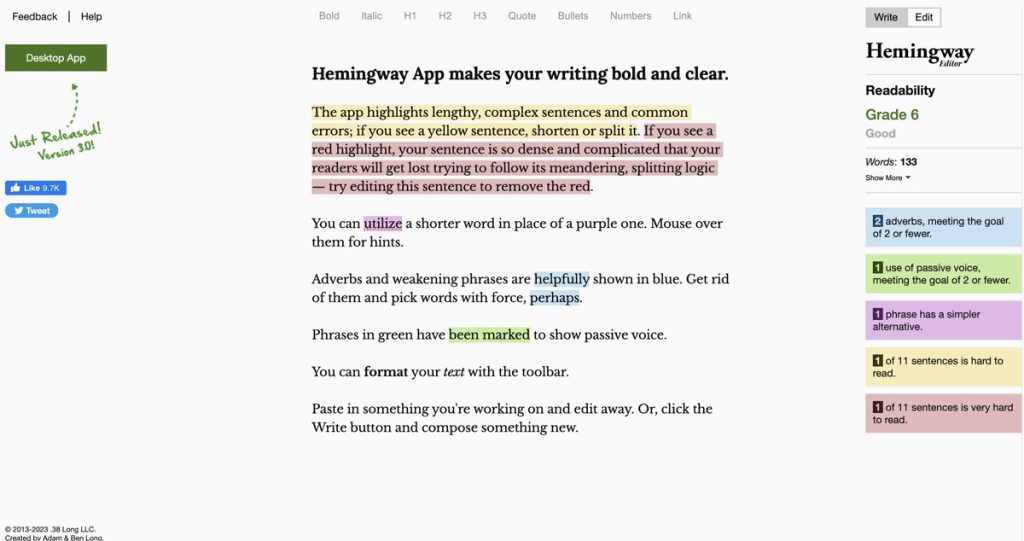
The Hemingway Editor focuses on enhancing the readability of content. Ideal for writers aiming to simplify complex text, it ensures content is digestible and engaging for a wide audience.
Features:
- Readability score.
- Style improvement suggestions.
- Simplicity and clarity focus.
Pricing:
- Free online version.
- Desktop app at $19.99.
Pros & Cons:
- Pros: Improves content clarity, easy to use.
- Cons: Lacks advanced content generation features.
3.8 Writesonic – Suitable for Freelancers and Social Media Marketers
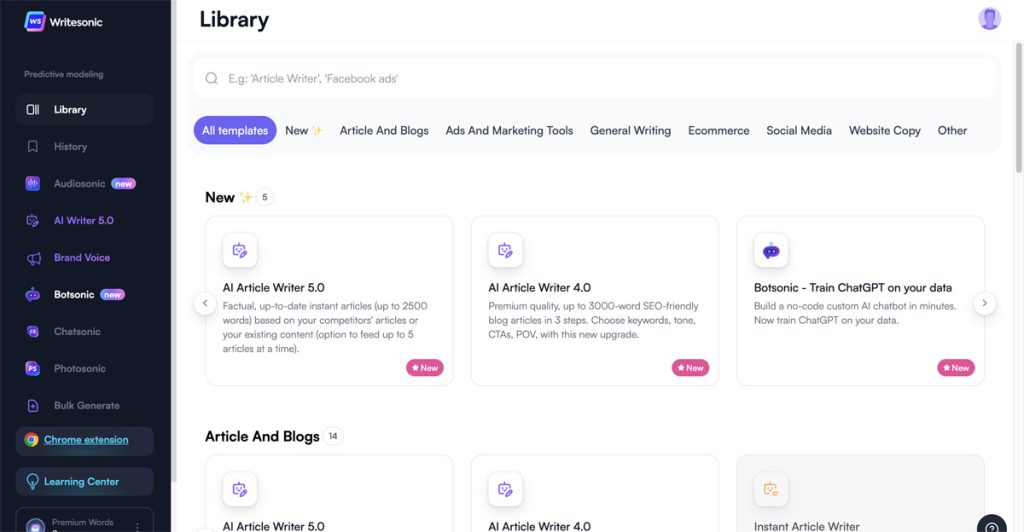
Writesonic is tailored for freelancers and social media marketers, offering rapid content creation tools. Its AI-powered solutions are geared towards creating catchy, attention-grabbing content.
Features:
- AI article and blog writer.
- Marketing copy generator.
- Quick content turnaround.
Pricing:
- Free trial available.
- Paid plans start at $19/month.
Pros & Cons:
- Pros: Fast content generation, diverse templates.
- Cons: Quality may vary, requiring manual editing.
3.9 AI Writer – Optimal for High-output Bloggers

AI Writer is designed for high-output bloggers and content creators. It offers seamless long-form content generation, aiding in producing detailed and informative articles.
Features:
- Automated research and writing.
- SEO content optimization.
- Simple content management.
Pricing:
- Starts at $19/user/month.
Pros & Cons:
- Pros: Efficient long-form content creation.
- Cons: Sometimes lacks depth in specialized subjects.
3.10 ContentatScale.ai – Best for Creating Long-form Content

ContentatScale.ai excels in generating long-form content. This tool is a boon for businesses and bloggers who require substantial, detailed articles that engage and inform their audience.
Features:
- AI-driven long-form content creation.
- Scalable content production.
- Integrated SEO optimization.
Pricing:
- Custom pricing based on requirements.
Pros & Cons:
- Pros: Excellent for bulk content creation.
- Cons: May require significant investment for full benefits.
Chapter 4: How to Choose the Right AI Writing Tool for Your Needs
4.1 Matching Tool Capabilities with Your Writing Objectives
Selecting the ideal AI writing tool requires a deep understanding of your specific content objectives. Whether it’s blog writing, crafting social media posts, or producing long-form content, each tool offers unique features that cater to different needs.
- Identify Your Content Goals: Are you focused on SEO content writing or more on creative storytelling? Tools like Anyword and Frase.io offer specialized features for SEO optimization, while Copy.ai is known for its creativity in overcoming writer’s block.
- Consider Content Type and Format: If your primary focus is on producing long-form content, tools like ContentatScale.ai and AI Writer offer robust solutions. Conversely, for shorter, more dynamic content, Writesonic and Copy.ai are more suitable.
4.2 Budget Considerations
Budget plays a critical role in the decision-making process. AI writing tools come with various pricing models, and it’s essential to find one that offers the best value for your investment.
- Subscription vs. Pay-Per-Use: Some tools offer monthly subscriptions like Grammarly and Rytr, while others may provide pay-per-use options. Evaluate which pricing model aligns best with your usage patterns.
- Free Trials and Basic Plans: Many AI tools offer free versions or trial periods. These can be a great way to test out features before committing financially.
4.3 Assessing Ease of Use and Support
The usability and support offered by an AI writing tool are crucial, especially if you’re new to AI-driven content creation.
- User Interface and Learning Curve: Tools like Hemingway Editor are known for their simplicity and ease of use, making them ideal for beginners. In contrast, tools with more complex features, such as Frase.io, might have a steeper learning curve but offer more advanced content optimization.
- Customer Support and Community: Consider the level of customer support provided. Access to responsive support and a robust user community can significantly enhance your experience with the tool.
Chapter 5: The Future of AI in Writing
5.1 Emerging Trends and Innovations
The landscape of AI in writing is continually evolving, with groundbreaking trends and innovations shaping the future of content creation. Here’s a glance at what’s on the horizon:
- Integration of Advanced AI Algorithms: AI writing tools are advancing beyond basic grammar checks and content generation. The integration of more sophisticated AI algorithms allows for nuanced and context-aware writing assistance, making AI-driven content increasingly indistinguishable from human writing.
- Personalized Writing Assistance: Future AI tools are expected to offer more personalized writing experiences, adapting to individual writing styles and preferences. This customization will lead to more effective and tailored content, particularly for blog writing and social media marketing.
- Enhanced Content Readability and Engagement: AI tools will continue to improve in assessing and enhancing the readability of content. By analyzing engagement metrics and reader feedback, AI writing software will be able to fine-tune content for maximum impact.
- AI Content Analysis and Optimization: The future will see AI tools providing deeper content analysis, offering insights into content performance and suggesting optimization strategies for better SEO content writing.
- AI Writing Innovation in Long-form Content: AI writing tools will become more adept at handling long-form content, offering more coherent and contextually relevant narratives. This will be a significant leap forward for content creators focusing on extensive articles or reports.
5.2 Predictions for AI Writing Tools Beyond 2023
See more : Speedwrite Review 2024: Unleash Writing Efficiency & Creativity
Looking beyond 2023, the potential of AI writing tools is limitless. Here are some predictions for the future:
- Voice and Tone Customization: Future AI tools might offer advanced customization options for voice and tone, making AI-generated content even more versatile and adaptable to various platforms and audiences.
- Seamless Integration with Other Software: Expect AI writing tools to integrate seamlessly with a wider range of software, including content management systems, marketing tools, and even virtual reality platforms.
- Rise of AI-driven Content Strategy: AI will play a more significant role in shaping overall content strategy. Tools will be capable of suggesting content topics, formats, and distribution channels based on market trends and audience preferences.
- Collaborative AI Writing: The development of collaborative AI features, where AI assists in real-time during collaborative writing sessions, could revolutionize how teams produce content.
- Ethical AI Writing Practices: With the growing use of AI in content creation, there will be an increased focus on ethical considerations, such as transparency about AI usage and the avoidance of AI-generated misinformation.
Chapter 6: FAQs
6.1 What are the main differences between AI writing tools?
AI writing tools differ primarily in their specific functionalities and target user base. Some tools, like Grammarly, focus heavily on grammar checking and punctuation error detection, making them ideal for academic and professional writing. Others, such as Copy.ai, are designed to aid in creative content creation, offering features like AI-driven content suggestions and diverse templates for blog writing and social media content.
6.2 How do AI writing tools improve content quality?
AI writing tools enhance content quality by providing automated writing solutions that include grammar and punctuation checks, content readability improvements, and SEO optimization. They utilize AI content analysis to suggest improvements, ensuring the content is not only error-free but also engaging and optimized for search engines.
6.3 Can AI writing tools replace human writers?
While AI writing tools are becoming increasingly sophisticated, they are not yet at a point where they can fully replace human writers. These tools excel at providing AI editing assistance, generating basic content drafts, and offering suggestions for content optimization. However, the nuances, creativity, and depth that a human writer brings, especially for long-form content and complex topics, are still unmatched by AI.
6.4 Are there any privacy concerns with using AI writing tools?
Privacy concerns in AI writing tools mainly revolve around data security and the handling of sensitive information. Reputable AI writing software companies often implement robust security measures to protect user data. However, users should be aware of the tool’s data handling policies and ensure sensitive information is protected.
6.5 How do AI writing tools integrate with other software?
AI writing tools integrate with various other software to enhance their functionality and usability. This includes integration with content management systems (CMS), social media platforms, email clients, and office applications. Integration allows for streamlined content creation and editing processes, making these tools more versatile and efficient in different working environments.
Chapter 7: Conclusion
7.1 Summary of Key Findings
As we conclude our exploration of AI writing tools, it’s evident that these innovative solutions have significantly transformed the landscape of content creation. The key findings from our analysis underscore the versatility and efficiency of AI tools in various aspects of writing:
- Diverse Functionality: AI writing tools like Grammarly and Hemingway Editor have redefined grammar checker capabilities and content readability, while platforms like Copy.ai and Anyword excel in creative blog writing and content generation.
- Targeted Solutions for Different Users: Each tool offers specialized features, making them suitable for distinct user groups, including social media marketers, bloggers, and SEO professionals.
- Technological Advancements: The continuous evolution in AI writing software is evident in the enhanced AI tool features, AI-driven content quality, and sophisticated AI content analysis.
- Impact on SEO and Content Strategy: AI tools have become indispensable for SEO content writing, offering content optimization and automated writing solutions that align with current digital marketing strategies.
7.2 Final Recommendations for Selecting an AI Writing Tool
Choosing the right AI writing tool is pivotal for maximizing content efficiency and quality. Based on our comprehensive AI comparison chart and in-depth analysis, we recommend the following:
- Assess Your Content Needs: Identify whether your primary requirement is for long-form content, SEO optimization, or creative writing. Select a tool that aligns with these needs.
- Consider Budget and Features: Balance the cost against the offered features. Tools like ContentatScale.ai and AI Writer, while potentially more expensive, provide extensive features for long-form content creation.
- Prioritize Usability and Support: Opt for tools that offer intuitive interfaces and reliable customer support, especially if you are new to AI-driven content creation.
7.3 Looking Forward to the Future of AI in Writing
As we look towards the future, AI writing innovation promises to bring even more sophisticated solutions. The integration of AI in content creation is not just a fleeting trend but a fundamental shift in how we approach writing. The potential for AI-driven content to evolve further, incorporating more nuanced understanding and creativity, suggests an exciting future for writers, marketers, and businesses alike.
In summary, AI writing tools represent a significant milestone in the digital content creation realm. By embracing these tools, content creators can enhance their writing quality, efficiency, and SEO effectiveness, staying ahead in the ever-evolving world of digital communication.
Latest Articles
Related Articles
Source: https://tasktwister.com
Category: AI







